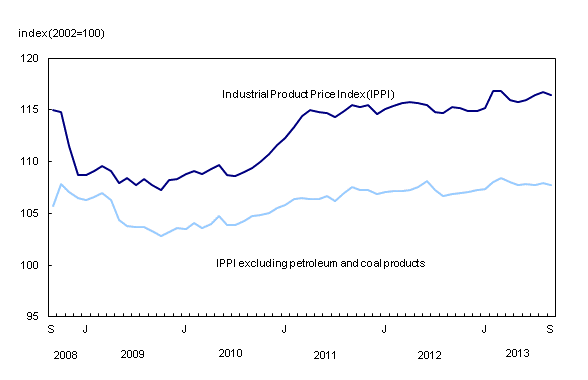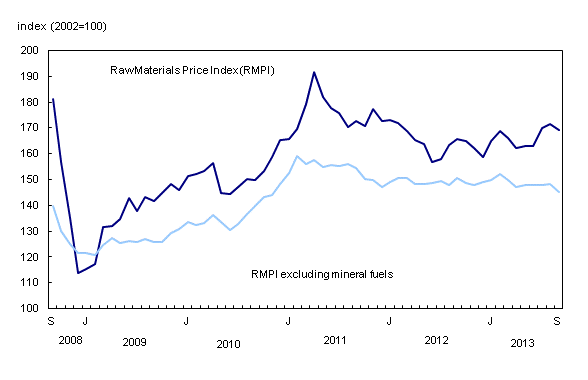Industrial product and raw materials price indexes, September 2013
Archived Content
Information identified as archived is provided for reference, research or recordkeeping purposes. It is not subject to the Government of Canada Web Standards and has not been altered or updated since it was archived. Please "contact us" to request a format other than those available.
Released: 2013-10-29
The Industrial Product Price Index (IPPI) declined 0.3% in September, mainly because of lower prices for primary metal products and petroleum and coal products. The Raw Materials Price Index (RMPI) fell 1.5%, led by mineral fuels and vegetable products.
Industrial Product Price Index, monthly change
After three consecutive monthly advances, the IPPI was down 0.3% in September, with 12 of the 21 major commodity groups posting declines.
Primary metal products (-0.9%) was the largest contributor to the decline of the index, mainly as a result of lower prices for aluminum products (-1.7%), copper and copper alloy products (-2.1%) and other non-ferrous metal products (-0.9%).
The decrease in the IPPI was also attributable to petroleum and coal products (-0.4%), which was down for the first time since April 2013. The downward movement was primarily a result of lower prices for gasoline (-1.9%). The IPPI excluding petroleum and coal products declined 0.2% in September.
To a lesser extent, meat, fish and dairy products (-0.9%) also contributed to the decrease in the IPPI, mainly because of lower prices for meat products (-1.4%).
Among other commodity groups posting declines was motor vehicles and other transportation equipment (-0.3%). This decrease was largely attributable to the appreciation of the Canadian dollar relative to the US dollar in September.
Some Canadian producers who export their products report their prices in US dollars. Consequently, the 0.6% increase in the value of the Canadian dollar relative to the US dollar may have had the effect of decreasing the IPPI. Without the measurable effect of the exchange rate, the index would have fallen 0.1% instead of 0.3%.
Conversely, the decline of the IPPI was moderated slightly by lumber and other wood products (+0.8%), mainly because of higher prices for softwood lumber (+2.2%).
Industrial Product Price Index, 12-month change
The IPPI rose 1.0% in the 12-month period ending in September, after increasing 1.7% in August. On a year-over-year basis, the index has not recorded a decline since December 2012.
Compared with September 2012, the advance of the IPPI was mainly attributable to motor vehicles and other transportation equipment (+3.5%), specifically motor vehicles (+4.7%). The depreciation of the Canadian dollar relative to the US dollar on a year-over-year basis was largely responsible for the increase.
Petroleum and coal products (+2.3%) also exerted upward pressure on the index on a year-over-year basis, largely as a result of higher prices for other petroleum and coal products (+7.1%), specifically liquefied petroleum gases (+17.7%). The fuel oils and other fuel group (+3.7%), particularly diesel fuel, was also up in relation to September 2012. The IPPI excluding petroleum and coal products advanced 0.7% on a year-over-year basis.
To a lesser extent, pulp and paper products (+3.9%) also contributed to the year-over-year increase in the IPPI, mainly as a result of higher prices for pulp (+7.1%). Lumber and other wood products, electrical and communication products, and machinery and equipment also posted higher prices over a 12-month period.
Compared with September 2012, the 5.4% depreciation of the Canadian dollar relative to the US dollar may have had the effect of increasing the IPPI. Without the measurable effect of the exchange rate, the index would have declined 0.4% instead of rising 1.0%.
Compared with the same month a year earlier, the growth of the IPPI was moderated largely by primary metal products (-6.0%), particularly other non-ferrous metal products (-17.8%). The decline in other non-ferrous metal products was led by lower prices for silver and platinum, on a year-over-year basis.
Raw Materials Price Index, monthly change
The RMPI fell 1.5% in September, the first decrease since April 2013. Although all major commodity groups posted lower prices, the decline of the RMPI was mostly attributable to mineral fuels and vegetable products.
Mineral fuels (-0.9%) was the largest contributor to the decrease in the RMPI, as a result of lower prices for crude oil (-1.0%). The RMPI excluding mineral fuels was down 2.0% in September.
Vegetable products (-5.3%) also exerted downward pressure on the RMPI, primarily because of lower prices for oilseeds (-12.4%) and grains (-5.0%). It was the largest decrease in vegetable products since October 2008.
To a lesser extent, non-ferrous metals (-2.4%) also contributed to the decline of the RMPI. All major non-ferrous metal groups posted lower prices in September, with the exception of non-ferrous metal scrap, which rose 0.7%. The largest contributors to the decrease were copper concentrates (-3.5%) and radioactive concentrates (-5.0%).
Raw Materials Price Index, 12-month change
During the 12-month period ending in September, the RMPI advanced 2.1% after increasing 5.1% in August.
Compared with September 2012, mineral fuels (+8.5%) was the largest contributor to the increase of the RMPI, mainly as a result of higher prices for crude oil (+8.6%). The RMPI excluding mineral fuels was down 3.6% on a year-over-year basis.
Among other commodity groups that contributed to the year-over-year increase in the RMPI were animals and animal products (+7.2%), ferrous materials (+10.5%) and wood products (+3.4%).
Compared with the same month a year earlier, non-ferrous metals (-11.8%) slightly moderated the upward movement of the RMPI, mainly because of lower prices for copper concentrates (-12.1%), precious metals (-20.8%) and radioactive concentrates (-24.9%).
Vegetable products (-15.4%) was also down on a year-over-year basis.
Note to readers
Statistics Canada is undertaking two important initiatives for the Industrial Product Price Index (IPPI) and the Raw Materials Price Index (RMPI) program.
Changes will soon be made in the IPPI and RMPI classification, and the basket will be updated (2010=100). These changes will be made at the end of 2013. For more information, see Upcoming changes.
Concordance information between the old CANSIM vectors and the new CANSIM vectors is available upon request by calling (toll-free 1-800-263-1136; 514-283-8300; infostats@statcan.gc.ca).
Note to readers
As a result of the US government shutdown, September IPPI data normally collected from US Bureau of Labor Statistics, representing 6.7% of the total IPPI, has been imputed and will be revised with the next release, as per the IPPI revision policy.
With each release, data for the previous six months may have been revised. The indexes are not seasonally adjusted.
The Industrial Product Price Index (IPPI) reflects the prices that producers in Canada receive as the goods leave the plant gate. It does not reflect what the consumer pays. Unlike the Consumer Price Index, the IPPI excludes indirect taxes and all the costs that occur between the time a good leaves the plant and the time the final user takes possession of it, including the transportation, wholesale, and retail costs.
Canadian producers export many goods. They often indicate their prices in foreign currencies, especially in US dollars, which are then converted into Canadian dollars. In particular, this is the case for motor vehicles, pulp, paper and wood products. Therefore, a rise or fall in the value of the Canadian dollar against its US counterpart affects the IPPI. But the conversion into Canadian dollars only reflects how respondents provide their prices. This is not a measure that takes the full effect of exchange rates into account.
The conversion of prices received in US dollars is based on the average monthly exchange rate (noon spot rate) established by the Bank of Canada, and it is available on CANSIM in table 176-0064 (series v37426). Monthly and annual variations in the exchange rate, as described in the release, are calculated according to the indirect quotation of the exchange rate (for example, CAN$1 = US$X).
The Raw Materials Price Index (RMPI) reflects the prices paid by Canadian manufacturers for key raw materials. Many of those prices are set on the world market. However, as few prices are denominated in foreign currencies, their conversion into Canadian dollars has only a minor effect on the calculation of the RMPI.
Table CANSIM table329-0056: Industrial Product Price Index, by major commodity aggregations.
Table CANSIM table329-0057: Industrial Product Price Index, by industry.
Table CANSIM table329-0058: Industrial Product Price Index, by stage of processing.
Tables CANSIM table329-0059 to 329-0068: Industrial Product Price Index, by commodity.
Table CANSIM table330-0007: Raw Materials Price Index, by commodity.
Definitions, data sources and methods: survey numbers survey number2306 and survey number2318.
The September 2013 issue of Industry Price Indexes (Catalogue number62-011-X) will be available soon.
The industrial product and raw materials price indexes for October will be released on November 28.
Contact information
For more information, or to enquire about the concepts, methods or data quality of this release, contact us (toll-free 1-800-263-1136; 514-283-8300; infostats@statcan.gc.ca) or Media Relations (613-951-4636; statcan.mediahotline-ligneinfomedias.statcan@canada.ca).
- Date modified:



